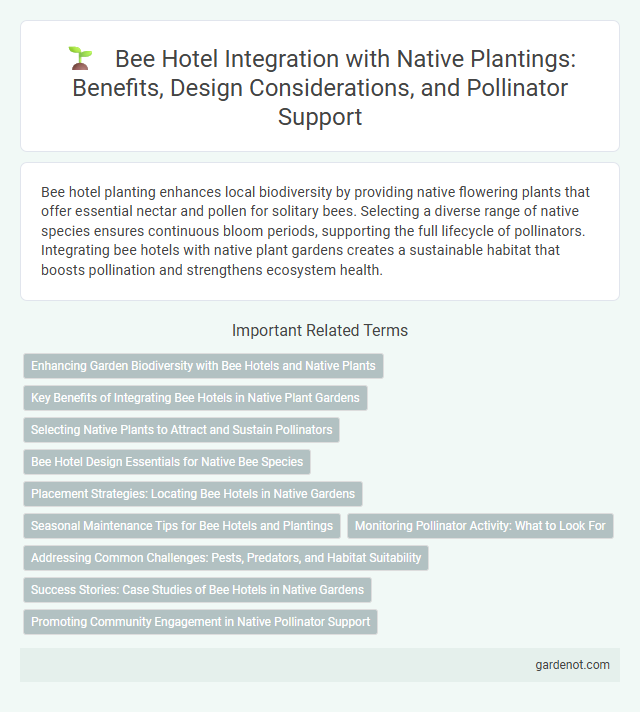Bee hotel planting enhances local biodiversity by providing native flowering plants that offer essential nectar and pollen for solitary bees. Selecting a diverse range of native species ensures continuous bloom periods, supporting the full lifecycle of pollinators. Integrating bee hotels with native plant gardens creates a sustainable habitat that boosts pollination and strengthens ecosystem health.
Enhancing Garden Biodiversity with Bee Hotels and Native Plants
Bee hotels provide essential nesting habitats for solitary bees, boosting pollination rates and supporting local ecosystems. Integrating native plants around bee hotels enhances food sources, creating a balanced environment that attracts diverse pollinators. This combination promotes garden biodiversity, improves plant health, and strengthens ecological resilience against environmental stressors.
Key Benefits of Integrating Bee Hotels in Native Plant Gardens
Integrating bee hotels in native plant gardens significantly enhances pollination rates by providing essential habitat for solitary bees, which are key pollinators of native flora. These structures support biodiversity by encouraging the presence of various native bee species, contributing to a balanced ecosystem. Additionally, bee hotels help boost plant health and yield by facilitating effective pollination, leading to more robust growth and increased seed production in native gardens.
Selecting Native Plants to Attract and Sustain Pollinators
Selecting native plants such as milkweed, goldenrod, and coneflower provides essential nectar and pollen sources that attract and sustain diverse pollinators like bees and butterflies. Native plant species have co-evolved with local pollinators, ensuring optimal support for their life cycles and promoting biodiversity within bee hotel habitats. Incorporating a variety of native blooms throughout the growing season maximizes food availability, enhancing the effectiveness and sustainability of pollinator conservation efforts.
Bee Hotel Design Essentials for Native Bee Species
Bee hotel design essentials for native bee species emphasize the use of untreated wood with natural holes or bundled hollow stems that mimic native nesting habitats. Proper hole diameter ranging from 2 to 10 millimeters accommodates diverse native bees, while placing the hotel in a sunny, sheltered location ensures warmth and protection from predators. Incorporating a mix of flowering native plants nearby supports foraging needs and promotes successful propagation of native bee populations.
Placement Strategies: Locating Bee Hotels in Native Gardens
Locating bee hotels in native gardens requires selecting sunny, sheltered spots with minimal disturbance to support solitary bee populations effectively. Positioning near native flowering plants enhances foraging efficiency, while proximity to undisturbed soil benefits nesting and reproduction. Proper placement optimizes pollination services and biodiversity within the ecosystem.
Seasonal Maintenance Tips for Bee Hotels and Plantings
Regularly inspect bee hotels in spring and early summer to remove debris and check for occupancy, ensuring active nesting sites for native solitary bees. Plant a diverse range of native flowering species that bloom sequentially from early spring through late fall to provide continuous nectar and pollen sources. Clean and replace worn or moldy nesting materials in late autumn to prevent disease and promote healthy bee populations the following season.
Monitoring Pollinator Activity: What to Look For
Monitoring pollinator activity around bee hotel planting involves observing frequent visits by various native bee species, including mason bees and leafcutter bees, which use natural cavities for nesting. Key indicators include the presence of pollen on bees' bodies, active nest provisioning, and emerging offspring during peak flowering periods. Regular assessment helps track pollinator health and nesting success, guiding habitat improvements and native plant selection.
Addressing Common Challenges: Pests, Predators, and Habitat Suitability
Bee hotel planting enhances native pollinator habitats by incorporating plants that attract beneficial insects while deterring common pests such as aphids and mites. Selecting native flowering species with dense foliage provides natural cover against predators like birds and spiders, ensuring a safer nesting environment. Proper site placement considering sunlight and moisture levels optimizes habitat suitability, supporting robust bee populations and promoting ecosystem balance.
Success Stories: Case Studies of Bee Hotels in Native Gardens
Bee hotels integrated into native gardens have significantly increased local pollinator populations by providing essential nesting habitats for solitary bees like mason and leafcutter species. Success stories from community-driven projects in Australia and the Pacific Northwest demonstrate enhanced plant biodiversity and higher fruit yields due to improved pollination rates. Data shows that gardens with bee hotels experience up to a 40% rise in native bee activity, promoting ecological balance and supporting native flora regeneration.
Promoting Community Engagement in Native Pollinator Support
Bee hotel planting enhances native pollinator habitats by providing essential nesting sites for solitary bees, fostering local biodiversity and ecosystem health. Integrating native plant species around these structures maximizes pollen and nectar availability, attracting diverse pollinator populations. Community-driven initiatives centered on bee hotels increase environmental awareness and participation in conservation efforts, strengthening urban and rural pollinator networks.
Bee hotel planting Infographic

 gardenot.com
gardenot.com